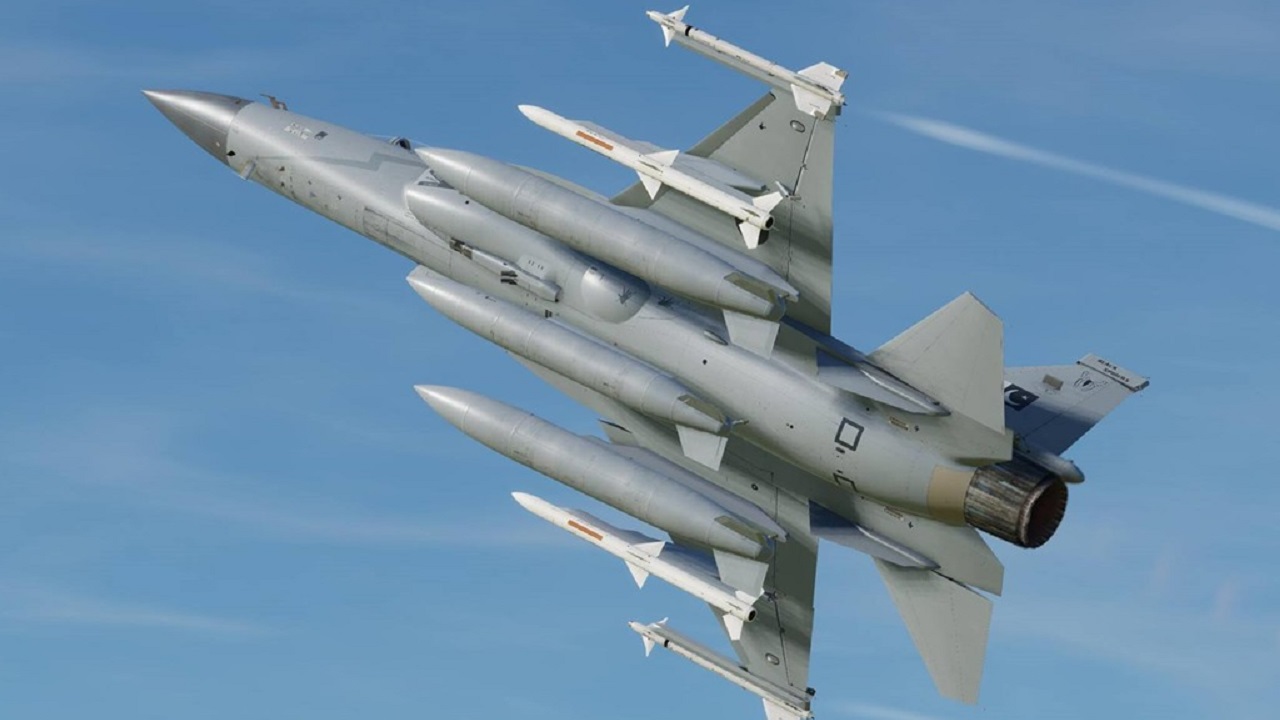While U.S. jets like the F-22 and F-35 get all of the buzz and attention, a little-known Chinese and Pakistani jet developed jointly soon could be in the skies all over the world. Meet the JF-17, and it could be a big hit:
In early November, three JF-17 fighters of the Pakistani Air Force conducted aerial demonstrations at the Bahrain International Air Show.
At the same time, China was showcasing the JF-17 at the annual China International Aviation and Aerospace Exhibition in Zuhai, China.
The events were the latest attempts by China and Pakistan to market their jointly developed fourth-generation fighter jet to international customers.
The JF-17 is only in service with three countries — Pakistan, Myanmar, and Nigeria — which operated a total of 145 as of October 2021, according to Aviation Week.
At the time, Aviation Week data showed that total was set to rise to 185 JF-17s by mid-decade — growth that would make it the most widely operated Chinese combat jet in service overseas by the end of 2023.
Meet the JF-17 Thunder
Developed by China’s Chengdu Aircraft Industry Corporation and the Pakistan Aeronautical Complex, the JF-17 first flew in 2003. The single-seat, single-engine jet is known in Pakistan as the JF-17 Thunder and as the FC-1 Xiaolong in China.
With a service ceiling of 50,000 feet and a top speed of about 1,200 mph, the JF-17 can perform several missions, including aerial intercept and ground attack. It can carry roughly 7,000 pounds of ordnance on seven hardpoints and is armed with a single twin-barrel 23 mm autocannon.
The first few JF-17s were made entirely in China, but Pakistan now does most of the production. At present, 58% of the aircraft is made in Pakistan and 42% in China.
Despite its joint development, only Pakistan chose to introduce it into service, officially doing so in 2007. The jet is meant to replace Pakistan’s aging fleet of Nanchang A-5, Chengdu F-7, and Mirage III and V attack and fighter jets.
With at least 125 in service, the JF-17 is the backbone of the PAF. They have reportedly been used to conduct airstrikes against militants in northwestern Pakistan and, according to one report, to down an Iranian-made drone in southwestern Pakistan in 2017.
Current and retired Pakistani air force officials also said a JF-17 shot down an Indian MiG-21 during an air-to-air skirmish in February 2019. (India said its jet was downed by a Pakistani F-16.)
The JF-17 has been upgraded several times since its introduction. The most recent version, the Block III, first flew in late 2019 and features several considerable improvements, including an additional hardpoint, a quad-redundant digital fly-by-wire system, and an active electronically scanned array radar.
Pakistan considers the Block III JF-17 a 4.5-generation jet, and its air force plans to acquire at least 50 of them, the first of which arrived in January. The jets have already been seen carrying one of China’s most advanced air-to-air missiles.
Affordable and appealing
Pakistan currently operates the most JF-17s. Myanmar, the first international customer, operates six and Nigeria has three.
Ranging from $15 million to $25 million each, the JF-17 is considerably cheaper than virtually every other fourth-generation jet on the market. Add-ons that increase its lethality, like targeting pods, makes it attractive to countries with low defense budgets that want multirole combat jets.
“Its not cutting edge, but it is a reliable performer,” Timothy Heath, a senior international and defense researcher at the Rand Corporation think tank, told Insider.
“This is not an aircraft that is designed to compete head-to-head with the F-22, so it doesn’t need the most sophisticated engines and parts,” Heath said. “It’s a cheap multirole budget aircraft that is suitable and probably most appealing to developing countries that are looking for a basic aircraft to either bomb their own people, like insurgents, or to carry out basic defense against similar-type countries.”
Several countries have expressed interest in the JF-17. Iraq has reportedly agreed to buy at least 12, and Egypt has said it’s interested in acquiring JF-17s as part of expanded defense cooperation with Pakistan. Azerbaijan has said for years that it wants JF-17s, and both Bolivia and Argentina are considering the jet.
Argentina has also sought to expand its local fighter production. Should it receive a license to build JF-17s domestically, it could make the jet more appealing to its neighbors.
Expanding JF-17 sales could help China increase its share of the market for “value arms” — weapons that are less sophisticated but still effective — among middle- and lower-income countries, which have long relied on Russia for jets, armored vehicles, and heavy artillery.
But selling more JF-17s may not translate into greater dependence on Chinese military hardware. Many countries still covet higher-end Western-built aircraft and are generally wary of becoming reliant on a single supplier, which is why many operate a mix of US, European, Russian, and Chinese aircraft.
“That’s a pretty common strategy in the developing world,” Heath said. “Most countries want autonomy, so they tend to want to have diverse suppliers, even though that does complicate their ability to operate all these foreign systems.”
This first appeared in Insider.
Want more 19FortyFive military, defense, and national security, as well as politics and economics analysis from the best experts on Earth? Follow us on Google News, Flipboard, YouTube, Facebook, Twitter, and Linkedin. Also, sign up for our newsletter here. You can also find our code of publishing ethics and standards here. Want to contact us? Email: [email protected].

